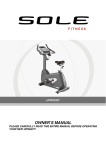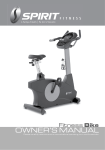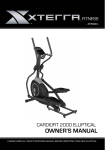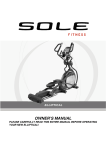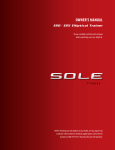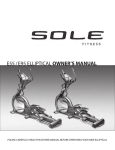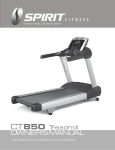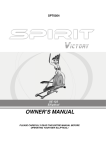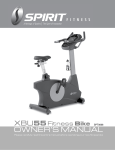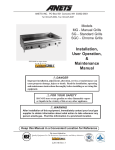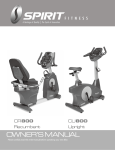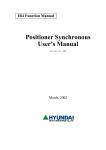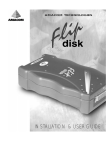Download user manual - Dyaco Sole
Transcript
Z100 / Z300 Z500 Z700 OWNER’S MANUAL PLEASE CAREFULLY READ THIS ENTIRE MANUAL BEFORE OPERATING YOUR NEW INDOOR CYCLE TABLE OFCONTENTS Important Safety Instructions 3 Important Operation Instructions 3 Transport Instructions 3 Assembly Instructions 4 Fitness Bike Features 8 Operation of Your New Fitness Bike 9 Programmable Features 13 Using Heart Rate Monitor 19 General Maintenance 21 Exploded View Diagram 22 Parts List 23 ATTENTION THIS FITNESS BIKE IS INTENDED FOR RESIDENTIAL USE ONLY AND IS WARRANTED FOR THE APPLICATION. ANY OTHER APPLICATION VOIDS THIS WARRANTY IN ITS ENTIRETY. SU879A-YB006_1403(SL)B 2 IMPORTANT SAFETY INSTRUCTIONS WARNING - Read all instructions before using this appliance. Do not operate fitness bike on deeply padded, plush or shag carpet. Damage to both carpet and fitness bike may result. Keep children away from the fitness bike. There are obvious pinch points and other caution areas that can cause harm. Keep hands away from all moving parts. Do not operate where aerosol spray products are being used or where oxygen is being administered. Sparks from the motor may ignite a highly gaseous environment. Never drop or insert any object into any openings. Do not use outdoors. Do not attempt to use your fitness bike for any purpose other than for the purpose it is intended. The hand pulse sensors are not medical devices. Various factors, including the user’s movement, may affect the accuracy of heart rate readings. The pulse sensors are intended only as exercise aids in determining heart rate trends in general. Wear proper shoes. High heels, dress shoes, sandals or bare feet are not suitable for use on your fitness bike. Quality athletic shoes are recommended to avoid leg fatigue or injury. SAVE THESE INSTRUCTIONS - THINK SAFETY! IMPORTANT OPERATION INSTRUCTIONS NEVER expose this fitness bike to rain or moisture. This product is NOT designed for use outdoors, near a pool or spa, or in any other high humidity environment. The operating temperature specification is 40 to 120 degrees Fahrenheit, and humidity is 95% non-condensing (no water drops forming on surfaces). NEVER operate this fitness bike without reading and completely understanding the results of any operational change you request from the computer. Understand that changes in resistance do not occur immediately. Set your desired resistance on the computer console and release the adjustment key. The computer will obey the command gradually. Use caution while participating in other activities while pedaling on your fitness bike; such as watching television, reading, etc. These distractions may result in serious injury. Do not use excessive pressure on console control keys. They are precision set to function properly with little finger pressure. If you feel the buttons are not functioning properly with normal pressure contact your SOLE dealer. TRANSPORT INSTRUCTIONS The fitness bike is equippped with two transport wheels which are engaged when the rear of the fitness bike is lifted. 3 ASSEMBLY PACK CHECKLIST 1 HARDWARE STEP 1 #50. 3/8” x 2-1/4” Hex Head Bolt (2 pcs) #58. M5 x 12mm Phillips Head Screw (2 pcs) #71. 3/8” x 25mm x 2T Flat Washer (2 pcs) 2 HARDWARE STEP 2 #51. 5/16” x 5/8” Hex Head Bolt (7 pcs) #72. 5/16” x 18mm x 1.5T Flat Washer (6 pcs) #99. 5/16” x 19 x 1.5T Curved Washer (1 pc) 3 HARDWARE STEP 3 #51. 5/16” x 5/8” Hex Head Bolt (2 pcs) 4 #72. 5/16” x 18mm x 1.5T Flat Washer (2 pcs) HARDWARE STEP 4 #58. M5 x 12mm Phillips Head Screw (6 pcs) 4 #103. 5/16” x 1.5T Split Washer (2 pcs) ASSEMBLY TOOLS #93. Phillips Head Screwdriver #92. 13/15mm Wrench #100. 12/14mm Wrench ASSEMBLY INSTRUCTIONS PRE-ASSEMBLY 1. Using a razor knife (Box Cutter) cut the outside, bottom, edge of box along the dotted Line. Lift Box over the unit and unpack. 2. Carefully remove all parts from carton and inspect for any damage or missing parts. If damaged parts are found, or parts are missing, contact your dealer immediately. 3. Locate the hardware package. Remove the tools first. Remove the hardware for each step as needed to avoid confusion. The numbers in the instructions that are in parenthesis (#) are the item number from the assembly drawing for reference. 5 1 REAR STABILIZE HARDWARE STEP 1 #50. 3/8” x 2-1/4” Hex Head Bolt (2 pcs) #58. M5 x 12mm Phillips Head Screw (2 pcs) #71. 3/8” x 25 x 2T Flat Washer (2 pcs) 1. Attach the Rear Stabilizer Cover (41) to the Rear Stabilizer (5) with two 2. Phillips Head Screws (58). Tighten with the Phillips Head Screw Driver (93). Attach the Rear Stabilizer (5) to the Main Frame (1) by sliding two Flat Washers (71) onto two Hex Head Bolts (50); insert the bolts through the Rear Stabilizer Attachment Plate (131), then into the Rear Stabilizer. Tighten using the 12/14 mm Wrench (100). 2 CONSOLE MAST HARDWARE STEP 2 #51. 5/16” x 5/8” Hex Head Bolt (7 pcs) #72. 5/16” x 18 x 1.5T Flat Washer (6 pcs) #99. 5/16” x 19 x 1.5T Curved Washer (1 pcs) 1. 2. Unravel the Computer (29) and Ground (32) cables, then pull the twist tie wire through the Console Mast Cover (38) (see illustration for the correct orientation of the cover)and the Console Mast (2) until the cable connector comes out the top opening of the console mast Attach the Console Mast (2) onto the Main Frame (1) with the seven Hex Head Bolts (51). Place six Flat Washers (72) on the side bolts and one Curved Washer (99) on the front bolt. Tighten using the 12/14mm Wrench (100). 6 3 HANDLE BAR HARDWARE STEP 3 #51. 5/16” x 5/8” Hex Head Bolt (2 pcs) #72. 5/16” x 18 x 1.5T Flat Washer (2 pcs) #103. 5/16” x 1.5T Split Washer (2 pcs) 1. 2. 3. Remove the plastic tie that is holding the plastic cover on the center of the handlebars. Feed the Hand Pulse Cables (26 & 28) through the opening of the handlebar mounting bracket (front of 2) and console mounting bracket (back of 2) . Attach the Handle Bar (3) to the Front Console Mast (2) with the two Hex Head bolts (51), two Flat Washers (72) and two Split Washers (103). Tighten using the 12/14mm Wrench (100). 4 PLASTIC PARTS 1. 2. 3. 4. 5. HARDWARE STEP 4 See page 8 for illustration Untie the twist tie that holds the two cables together and discard it. Insert theComputer Cable (29), Ground Cable (32), and two Hand pulse cables (26 & 28) into the connectors in the back of the Console (34). Attach the Console (34) onto the Console Mast (2) with four Phillips Head Screws (58). Tighten using the Phillips Head Screw Driver (93). Attach the Front Stabilizer Cover (40) to the Main Frame (1) with two Phillips Head Screws (58). Tighten with the Phillips Head Screw Driver (93). Install the Pedals (45 L, 46 R) onto the Cranks by using the 13/15mm Wrench (92). Remember that the left pedal has a reverse thread and will be screwed into the crank in the opposite rotation from normal threads. There is an L stamped into the end of the threaded post of the left pedal and an R on the end of the right post. Make sure to tighten the pedals as much as you possibly can. It may be necessary to re-tighten the pedals if you feel a thumping while pedaling the bike. A clicking noise or thumping feeling is usually caused by loose pedals. Attach the Seat (19) to the Seat Post (7) using the 12/14mm Wrench (100). 7 #58. M5 x 12mm Phillips Head Screw (6 pcs) 4 ASSEMBLY STEP 4 FITNESS BIKE FEATURES FOOT PEDALS Through research performed with a leading sports scientist and physical rehabilitation expert, Sole engineering has developed a breakthrough in pedal design. Typical stationary exercise bikes are wider than a normal road bike. The reason is to allow for the braking mechanism, pulleys, drive components and plastic covers. Since the bike is wider, so is the distance between the pedals; this width between the pedals is called the Q factor. Sole has designed our pedal system so the Q factor is the smallest in the industry, but we did not stop there. We have also custom designed and tooled a new pedal that provides a two degree inward tilt to compensate for the Q factor not being perfect. Having a small Q factor in addition to the two-degree inward tilt of the pedals puts the user into a biomechanical neutral alignment. This means that your feet, ankles, knees and hips are lined up properly ensuring a comfortable workout. 8 OPERATION OF YOUR FITNESS BIKE GETTING FAMILIAR WITH THE CONTROL PANEL CONSOLE COOLING FAN QUICK LEVEL KEYS DATA DISPLAY PROGRAM BUTTONS DOT MATRIX (Manual, Hill, Fat Burn, Cardio, Strength, Interval, Custom, Fit-Test, 2HR) MESSAGE WINDOW (Program Profiles) (Time, Program Name, Distance, RPM, Calories, Laps, Level, Watts, & Pulse) DISPLAY FAN POWER SWITCH CONTROL KEYS HEADPHONE JACK AUDIO IN JACK (MP3, CD, or SMARTPHONE) POWER UP The console power is created by a built in generator. When you begin pedaling the fitness bike, the console will automatically power up. If there is no movement at the flywheel, the console will go to stand-by mode. In stand-by mode the console display will turn off. To turn the console on, begin pedaling. When it is first powered on, the console will perform an internal self-test. During this time all the lights will turn on. When the lights go off, the Message window will show a software version (i.e.: VER 1.0) and the Distance window will display an odometer reading. The odometer reading displays how many virtual miles the fitness bike has gone. The Time window displays how many hours the fitness bike has been used. The odometer and time will remain displayed for only a few seconds then the console will go to the startup display. The dot matrix display will be scrolling through the different workout profiles and the Message window will be scrolling the start up message. You may now begin to use the console. 9 CONSOLE OPERATION QUICK START This is the quickest way to start a workout. After the console powers up you just press the Start key to begin, this will initiate the Quick Start mode. In Quick Start the Time will count up from zero and the workload and the resistance may be adjusted manually by pressing the Up or Down buttons or pressing one of the Quick Level Keys 1, 4, 8, 12, 16, 20, 21, 24, 28, 32, 36, or 40 on the left or right side of the console. The dot matrix display will be showing a track with a blinking dot indicating your progress as it travels around the track. BASIC INFORMATION The Message Window will initially be displaying the Speed in MPH. Each time the Display Button - located left of the display - is pressed the next set of information will appear. The information displayed will be: Speed in MPH, Watts, METs and Segment Time. Pressing the Display Button one more time will set the display to Scan mode where all of the information will be displayed sequentially for 4 seconds each. The Dot Matrix will show the Resistance profile of the program and a Lap Track that is a ¼ mile long. There is an Audio Input Jack ( ) on the front of the console and built-in speakers. You may plug any low-level audio source signal into this port. Audio sources include MP3, iPod, portable radio, CD player or even a TV or computer audio signal. There is an audio patch cable included to and also a Headphone jack ( ) for private listening. DOT MATRIX CENTER DISPLAY The fitness bike has a built in heart rate monitoring system. Simply grasping the Contact Heart Rate Sensors on the handle bars or wearing a chest strap transmitter (sold separately) will start the heart (see Heart Rate Programs) Icon blinking (this may take a few seconds). The Pulse Window will display your heart rate in beats per minute and the HR bar graph will show your current % in relation to projected heart rate maximum. The chest strap is a more accurate and reliable method of heart rate reading. The hand pulse sensors are subject to false readings depending on user physiology and workout habits including how one grips the sensors or how sweaty their hands are. Because of the generator system, the console will shut off if there isn’t any movement at the flywheel. If you are in a program and have to stop pedaling, your information will be saved for up to 5 minutes. When you resume pedaling, the program will continue at that point and data will continue to accumulate from where you left off. If more than 5 minutes has elapsed, the console will return to the start up screen and all data from that workout will be lost. 10 The Stop button actually has several functions. Pressing the Stop key once during a program will Pause the program. If the Stop button is pressed twice during a workout the program will end and a Workout Summary is displayed. If the Stop key is held down for 3 seconds the console will perform a complete Reset. During data entry for a program the Stop key performs a Previous Screen function. This allows you to go back one step in the programming each time you press the Stop key. PROGRAMMING THE CONSOLE Each of the programs can be customized with your personal information and changed to suit your needs. Some of the information asked for is necessary to ensure the readouts are correct. You will be asked for your Age and Weight. Entering your Age is necessary during the Heart Rate control program to ensure the correct settings are entered in the program; entering your exact Weight results in a more accurate Calorie calculation. Although we cannot provide an exact calorie count we do want to be as close as possible. A message about Calories: Calorie readings on every piece of exercise equipment, whether it is in a gym or at home, are not accurate and tend to vary widely. They are meant only as a guide to monitor your progress from workout to workout. The only way to measure your calorie burn accurately as in a clinical setting connected to a host of machines. This is because every person is different and burns calories at a different rate. ENTERING A PROGRAM AND CHANGING SETTINGS Press each program button to scroll through the program selections. The profile for each program will be displayed in the dot matrix window. Press the Enter key to select a program and begin customizing the settings. If you want to workout without entering new settings, then just press the Start key. This will bypass the programming of data and take you directly to the start of your workout. If you want to change the personal settings, then just follow the instructions in the message window. If you start a program without changing the settings, the default settings will be used. Note: Age and Weight default settings will change when you enter a new number. So the last Age and Weight entered will be saved as the new default settings. If you enter Age and Weight the first time you use the fitness bike you will not have to enter it every time you work out unless either Age or Weight has changed or someone else enters a different Age and Weight. 11 PROGRAMMABLE FEATURES MANUAL PROGRAM The Manual program works as the name implies, manually. This means that you control the workload yourself and not the computer. 1. Press the Manual program button then press the Enter key. 2. The Message Window will ask you to enter your Age. You may adjust the age setting using the Up and Down keys, then press the Enter key to accept the new number and proceed on to the next screen. 3. You are now asked to enter your Weight. You may adjust your weight setting using the Up and Down keys, then press Enter to continue. 4. Next is the Time. You may adjust the length of Time by pressing the Up or Down keys, then press Enter to continue.. 5. Now you are finished editing the settings and can begin your workout by pressing the Start key. You can also go back and modify your settings by pressing the Stop key to go back one level of the programming screen. 6. Once the program starts the fitness bike will be set to level one. This is the easiest level and it is a good idea to stay at level one for a while to warm up. If you want to increase the work load at any time press the Up key; the Down key will decrease the workload. You can also press any of the Quick Level keys. 7. During the Manual program you will be able to scroll through the data in the message window by pressing the Display key. 8. When the program ends the message window will show a summary of your workout. The summary will be displayed for a short time then the console will return to the start-up display. 12 PRESET PROGRAMS The fitness bike has five different programs that have been designed for a variety of workouts. These five programs have factory preset work level profiles for achieving different goals. Hill The Hill program simulates going up and down a hill. The resistance in the pedals will steadily increase and then decrease during the program. WORK Fat Burn The Fat Burn program is designed, as the name implies, to maximize the burning of fat. There are many schools of thought on the best way to burn fat but most experts agree that a lower exertion level that stays at a steady workload is the best. The absolute best way to burn fat is to keep your heart rate at around 60% to 70% of its maximum potential. This program does not use heart rate but simulates a lower, steady exertion workout. WORK Cardio The Cardio program is designed to increase your cardiovascular function and endurance. This is exercise for your heart and lungs. It will build up your heart muscle and increase blood flow and lung capacity. This is achieved by incorporating a higher level of exertion with slight fluctuations in work. WORK Strength The Strength program is designed to increase muscular strength in your lower body. This program will steadily increase in resistance to a high level and forces you to sustain it. This is designed to strengthen and tone your legs and glutes (muscles of the butt). WORK Interval The Interval program takes you through high levels of intensity followed by periods of low intensity. This program increases your endurance by depleting your oxygen level followed by periods of recovery to replenish oxygen. Your cardiovascular system gets programmed to use oxygen more efficiently this way. This program also forces your body to become more efficient due to spikes in heart rate, between recovery periods. This aids in heart rate recovery from intense activities WORK 13 PROGRAMMING PRESET BUTTONS 1. 2. 3. 4. 5. 6. 7. 8. 9. Press the desired program button then press the Enter key. The message window will ask you to enter your Age. You may adjust the age setting, using the Up and Down keys, then press the Enter key to accept the new number and proceed on to the next screen. You are now asked to enter your Weight. You may adjust your weight using the Up and Down keys then press Enter to continue. Next is Time. You may adjust the Time and press Enter to continue. Now you are asked to adjust the Max Level. This is the peak exertion level you will experience during the program (the highest colored segment/box of the program profile). Adjust the level and then press Enter. Now you are finished editing the settings and can begin your workout by pressing the Start key. You can also go back and modify your settings by pressing the Stop key to go back one screen or Enter to go back to the beginning. If you want to increase or decrease the resistance at any time during the program press the Up or Down keys. During the program you will be able to scroll through the data in the message window by pressing the Display key. When the program ends the message window will show a summary of your workout. The summary will be displayed for a short time then the console will return to the start-up display. CUSTOM PROGRAM The customizable User program allows you to build and save your own workout. Follow the instructions below. 1. Select the Custom program then press Enter. If you have already saved a program, it will be displayed and you are ready to begin. If not or someone else’s name is shown, you will have the option of overriding or inputting a username. In the message window, the letter “A” will be blinking. Use the Up and Down buttons to select the appropriate first letter of your name (pressing the Up button will switch to the letter “B”; pressing the Down button will switch to letter “Z”). Press Enter when the desired letter is displayed. Repeat this process until all of the characters of your name have been programmed (maximum 7 characters). When finished press Stop. 2. If there is a program already stored in Custom when you press the key, you will have an option to run the program as it is or delete the program and build a new one. At the welcome message screen, when pressing Start or Enter you will be prompted: Run Program? Use the Up/Down arrows to select Yes or No. If you select No, you will then be asked if you want to delete the currently saved program. It is necessary to delete the current program if you want to build a new one. 3. The message window will ask you to enter your Age. You may enter your age using the Up and Down keys, then press the Enter key to accept the new number and proceed on to the next screen. 4. You are now asked to enter your Weight. You may adjust the weight number using the Up and Down keys, then pressEnter to continue. 5. Next is Time. You may adjust the Time using the Up and Down keys and press Enter to continue. 14 6. Now the first column will be blinking and you are asked to adjust the level for the first segment of the workout. When you finish adjusting the first segment, or if you don’t want to change, then press Enter to continue to the next segment. The next segment will show the same level as the previously adjusted segment. Repeat the same process as the last segment then press Enter. Continue this process until all twenty segments have been set. 7. The message window will then tell you to start to begin (and save the program) or Enter to modify the program. Pressing Stop will exit to the start up screen. 8. If you want to increase or decrease the workload at any time during the program press the Up or Down key. This will only affect the resistance for the present column in the profile. When the profile changes to the next column it will return to the preset work level. 9. During the Custom program you will be able to scroll through the data in the message window by pressing the Display key. 10. When the program ends the message window will show a summary of your workout. The summary will be displayed for a short time then the console will return to the start-up display. FITNESS TEST PROGRAM The fitness test is based on the YMCA protocol and is a sub-maximal test that uses pre-determined, fixed work levels that are based on your heart rate readings as the test progresses. The test will take anywhere between 6 to 15 minutes to complete, depending on your level of fitness. The test ends when your heart rate reaches 85% of maxi- mum at any time during the test or your heart rate is between 110 bpm and 85% at the end of two consecutive stages. At the end of the test a VO2max score will be given. VO2max stands for Volume of Oxygen uptake which is a measurement of how much oxygen you need to perform a known amount of work. The YMCA protocol uses two to four, 3 minute stages of continuous exercise (see charts below). You will be asked to choose either, Male or Female at the beginning of the test. This choice determines which test parameters will be used during the test as show in the charts below. The only caveats are that if you are a very de-conditioned Male you need to choose option Female. If you are a very conditioned female you need to choose option Male. Workload chart for male or very fit female: 1st Stage 300 kgm/min HR <90 90-105 >105 2nd stage 900 kgm/min 750 kgm/min 600 kgm/min HR HR<120 HR120-135 HR>135 HR>120 HR120-135 HR>135 HR>120 HR120-135 HR>135 3rd stage 1350 kgm/min 1200 kgm/min 1050 kgm/min 1200 kgm/min 1050 kgm/min 900 kgm/min 1050 kgm/min 900 kgm/min 750 kgm/min Workload chart for female or de-conditioned male 1st Stage 150 kgm/min Heart Rate HR<80 HR: 80-90 HR: 90-100 2nd Stage 750 kgm/min 600 kgm/min 450 kgm/min 300 kgm/min 3rd Stage 900 kgm/min 750 kgm/min 600 kgm/min 450 kgm/min 4th Stage 1050 kgm/min 900 kgm/min 700 kgm/min 600 kgm/min 15 HR>100 Fitness Test Programming 1. 2. 3. 4. 5. Press the Fit-test button and press Enter. The message window will display Gender Male. The word Male will be blinking. Use the up and down arrows if you need to change to Female, then press Enter. The choice of Gender determines which workload chart will be used for the test. The message window will ask you to enter your Age. You may adjust the age setting, using the Up and Down keys then press the Enter key to accept the new number and proceed on to the next screen You are now asked to enter your Weight. You may adjust the weight number using the Up and Down keys then press enter to continue. Now press Start to begin the test or Enter to modify your settings. Before the test Make sure you are in good health; check with your physician before performing any exercise if you are over the age of 35 or persons with pre-existing health conditions. Make sure you have warmed up and stretched before taking the test. Do not take in caffeine before the test. Hold the hand grips gently, do not tense up. During the test The console must be receiving a steady heart rate for the test to begin. You may use the hand pulse sensors or wear a heart rate chest strap transmitter. You must maintain a steady 50 RPM pedal speed. If your pedal speed drops below 48 RPM or goes above 52 RPM the console will emit a steady beeping sound until you are within this range. You may scroll through the various data readings in the message window by pressing the Display button under the Message Window. 6. The message window will always display your pedal speed on the right side to help you maintain 50RPM. 7. The data shown during the test is: a. Work in KGM is actually an abbreviated form of kg-m/min. which is a work measurement of kilogram-force meter/minute b. Work in Watts (1 watt is equal to 6.11829727787 kg-m/min.) c. HR is your actual heart rate; TGT is the target heart rate to reach to end the test. d. Time is the total elapsed time of the test. After the test Cool down for about one to three minutes. Take note of your score because the console will automatically return to the start-up mode after a few minutes. WHAT YOUR SCORE MEANS VO2max Chart for males and very fit females excellent good above average average below average poor very poor 18-25 Years old >60 52-60 47-51 26-35 Years old >56 49-56 43-48 36-45 Years old >51 43-51 39-42 46-55 Years old >45 39-45 35-38 56-65 Years old >41 36-41 32-35 65+ Years old >37 33-37 29-32 42-46 37-41 40-42 35-39 35-38 31-34 32-35 29-31 30-31 26-29 26-28 22-25 30-36 <30 30-34 <30 26-30 <26 25-28 <25 22-25 <22 20-21 <20 VO2max Chart for females and de-conditioned males excellent good above average average below average poor very poor 16 18-25 Years old 56 47-56 42-46 26-35 Years old 52 45-52 39-44 36-45 Years old 45 38-45 34-37 46-55 Years old 40 34-40 31-33 56-65 Years old 37 32-37 28-31 65+ Years old 32 28-32 25-27 38-41 33-37 35-38 31-34 31-33 27-30 28-30 25-27 25-27 22-24 22-24 19-22 28-32 <28 26-30 <26 22-26 <22 20-24 <20 18-21 <18 17-18 <17 HEART RATE PROGRAMS Before we get started, a word about Heart Rate: The old motto, “no pain, no gain”, is a myth that has been overpowered by the benefits of exercising comfortably. A great deal of this success has been promoted by the use of heart rate monitors. With the proper use of a heart rate monitor, many people find that their usual choice of exercise intensity was either too high or too low and exercise is much more enjoyable by maintaining their heart rate in the desired benefit range. To determine the benefit range in which you wish to train, you must first determine your Maximum Heart Rate. This can be accomplished by using the following formula: 220 minus your age. This will give you the Maximum Heart Rate (MHR)for someone of your age. To determine the effective heart rate range for specific goals you simply calculate a percentage your MHR. Your Heart rate training zone is 50% to 90% of your maximum heart rate. 60% of your MHR is the zone that burns fat while 80% is for strengthening the cardio vascular system. This 60% to 80% is the zone to stay in for maximum benefit. For someone who is 40 years old their target heart rate zone is calculated: 220 – 40 = 180 (maximum heart rate) 180 x .6 = 108 beats per minute (60% of maximum) 180 X .8 = 144 beats per minute (80% of maximum) So for a 40 year old the training zone would be 108 to 144 beats per minute. If you enter your age during programming the console will perform this calculation automatically. Entering your age is used for the Heart Rate control programs. After calculating your MHR you can decide upon which goal you would like to pursue. The two most popular reasons for, or goals, of exercise are cardiovascular fitness (training for the heart and lungs) and weight control. The black columns on the chart above represent the MHR for a person whose age is listed at the bottom of each column. The training heart rate, for either cardiovascular fitness or weight loss, is represented by two different lines that cut diagonally through the chart. A definition of the lines’ goal is in the bottom left-hand corner of the chart. If your goal is cardiovascular fitness or if it is weight loss, it can be achieved by training at 80% or 60%, respectively, of your MHR on a schedule approved by your physician. Consult your physician before participating in any exercise program. With all Heart Rate Control fitness bike machines you may use the heart rate monitor feature without using the Heart Rate Control program. This function can be used during manual mode or during any of the nine different programs. The Heart Rate Control program automatically controls resistance at the pedals. 17 RATE OF PERCEIVED EXERTION Heart rate is important but listening to your body also has a lot of advantages. There are more variables involved in how hard you should workout than just heart rate. Your stress level, physical health, emotional health, temperature, humidity, the time of day, the last time you ate and what you ate, all contribute to the intensity at which you should workout. If you listen to your body, it will tell you all of these things. The rate of perceived exertion (RPE), also know as the Borg scale, was developed by Swedish physiologist G.A.V. Borg. This scale rates exercise intensity from 6 to 20 depending upon how you feel or the perception of your effort. The scale is as follows: Rating Perception of Effort 6 Minimal 7 Very,very light 8 Very,very light + 9 Very light 10 Very light + 11 Fairly light 12 Comfortable 13 Somewhat hard 14 Somewhat hard + 15 Hard 16 Hard + 17 Very hard 18 Very hard + 19 Very,very hard 20 Maximal You can get an approximate heart rate level for each rating by simply adding a zero to each rating. For example a rating of 12 will result in an approximate heart rate of 120 beats per minute. Your RPE will vary depending up the factors discussed earlier. That is the major benefit of this type of training. If your body is strong and rested, you will feel strong and your pace will feel easier. When your body is in this condition, you are able to train harder and the RPE will support this. If you are feeling tired and sluggish, it is because your body needs a break. In this condition, your pace will feel harder. Again, this will show up in your RPE and you will train at the proper level for that day. 18 USING HEART RATE TRANSMITTER(Optional) How to wear your wireless chest strap transmitter: 1. 2. 3. 4. 5. 6. Attach the transmitter to the elastic strap using the locking parts. Adjust the strap as tightly as possible as long as the strap is not too tight to remain comfortable. Position the transmitter with the logo centered in the middle of your body facing away from your chest (some people must position the transmitter slightly left of center). Attach the final end of the elastic strap by inserting the round end and, using the locking parts,secure the transmitter and strap around your chest. Position the transmitter immediately below the pectoral muscles. Sweat is the best conductor to measure very minute heart beat electrical signals. However, plain water can also be used to pre-wet the electrodes (2 ribbed oval areas on the reverse side of the belt and both sides of the transmitter). It’s also recommended that you wear the transmitter strap a few minutes before your work out. Some users, because of body chemistry, have a more difficult time in achieving a strong, steady signal at the beginning. After “warming up”, this problem lessens. As noted, wearing clothing over the transmitter/strap doesn’t affect performance. Your workout must be within range - distance between transmitter/receiver – to achieve a strong steady signal. The length of range may vary somewhat but generally stay close enough to the console to maintain good, strong, reliable readings. Wearing the transmitter immediately against bare skin assures you of proper operation. If you wish, you may wear the transmitter over a shirt. To do so, moisten the areas of the shirt that the electrodes will rest upon. Note: The transmitter is automatically activated when it detects activity from the user’s heart. Additionally, it automatically deactivates when it does not receive any activity. Although the transmitter is water resistant, moisture can have the effect of creating false signals, so you should take precautions to completely dry the transmitter after use to prolong battery life (estimated transmitter battery life is 2500 hours). The replacement battery is Panasonic CR2032. ERRATIC OPERATION Caution! Do not use this fitness bike for Heart Rate Control unless a steady, solid Actual Heart Rate value is being displayed. High, wild, random numbers being displayed indicate a problem. Areas to look for interference which may cause erratic heart rate: Microwave ovens, TV’s, small appliances, etc. Fluorescent lights. Some household security systems. Perimeter fence for a pet. Some people have problems with the transmitter picking up a signal from their skin. If you have problems try wearing the transmitter upside down. Normally the transmitter will be oriented so the logo is right side up. 6. The antenna that picks up your heart rate is very sensitive. If there is an outside noise source, turning the whole machine 90 degrees may de-tune the interference. 7. Another Individual wearing a transmitter within 3’ of your machine’s console. 1. 2. 3. 4. 5. If you continue to experience problems contact your dealer. 19 HEART RATE CONTROL PROGRAM OPERATION Both programs operate the same, the only difference is that HR1 is set to 60% and HR2 is set to 80% of the maximum heart rate. They both are programmed the same way. To start an HR program follow the instructions below or just select the HR1 or HR2 program, then the Enter button and follow the directions in the message window. 1. Press the HR1 or HR2 key then press the Enter key. 2. The message window will ask you to enter your Age. You may enter your Age, using the Up and Down keys, then press the Enter key to accept the new number and proceed on to the next screen. 3. 3. You are now asked to enter your Weight. You may adjust the Weight number using the Up and Down keys, then press Enter to continue. 4. Next is Time. You may adjust the Time and press Enter to continue. 5. Now you are asked to adjust your Target Heart Rate. This is the heart rate level you will strive to reach and maintain during the program. Adjust the level and then press Enter. NOTE: The heart rate that appears is based on the % you accepted in Step 1. If you change this number it will either increase or decrease the % from Step 1. 6. Now you are finished editing the settings and can begin your workout by pressing the Start key. You can also go back and modify your settings by pressing the Enter key. NOTE: At any time during the editing of Data you can press the Stop key to go back one level, or screen. 7. If you want to increase or decrease the workload at any time during the program press the Up or Down key. This will allow you to change your target heart rate at any time during the program. 8. During the HR1 or HR2 programs you will be able to scroll through the data in the message window by pressing the adjacent Display key. 9. When the program ends you may press Start to begin the same program again or Stop to exit the program. 20 GENERAL MAINTENANCE 1. 2. Wipe down all areas in the sweat path with a damp cloth after each workout. If a squeak, thump, clicking or rough feeling develops the main cause is most likely one of two reasons: I. The hardware was not sufficiently tightened during assembly. All bolts that were installed during assembly need to be tightened as much as possible. It may be necessary to use a larger wrench than the one provided if you cannot tighten the bolts sufficiently. I cannot stress this point enough; 90% of calls to the service department for noise issues can be traced to loose hardware. II. The crank arm nut needs to be retightened III. If squeaks or other noises persist, check that the unit is properly leveled. There are 2 leveling pads on the bottom of the rear stabilizer, use a 14mm wrench (or adjustable wrench) to adjust the levelers. MAINTENANCE MENU IN CONSOLE SOFTWARE 1. Press and hold the Start, Stop and Enter key at the same time, until the display shows “Engineering Mode”. Press the Enter key. 2. You can now scroll through the menu using the Up and Down keys. Use the Stop key to return to previous menu selection. The menu selections are: A. Key Test B. Display Test C. Functions I. Display Mode - Turn Off to have the console power down automatically after 30 minutes of inactivity II. Pause Mode - Turned On to allow 5 minutes of Pause, turn Off to Pause indefinitely III. ODO Reset - Resets the Odometer reading to zero IV. Units - Choose from English(Imperial) or Metric display readings V. Brake Test - For testing the Brake function D. Security E. Factory Settings - For Factory use only F. Exit 21 EXPLODED VIEW DIAGRAM 22 PARTS LIST NO. 1 2 3 5 6 7 8 9 11 13 14 15 16L 16R 17 18 19 20 21 22 23 24 25 26 28 29 30 31 32 34 35 36 37 38 40 41 42 43 45 46 47 49 50 51 52 53 54 55 56 DESCRIPTION Main Frame Console Mast Seat Handle Bar Rear Stabilizer Seat Slider Sliding Seat Mount Fix Plate Idler Wheel Assembly Crank Axle Chain Cover Bracket Drive Belt Drive Pulley Crank Arm(L) Crank Arm(R) 6004_Bearing 6203_Bearing Seat Generator/Brake Generator/Brake Controller Magnet 300m/m_Sensor W/Cable 1" × 5T × 285m/m_Handgrip Foam 1" × 5T × 200m/m_Handgrip Foam 800m/m_Handpulse W/Cable Assembly 800m/m_Handpulse W/Cable Assembly 2100m/m_Computer Cable 200m/m_Wire Brake Coil Harness Generator Wire Harness 1400m/m_Ground Wire Console assembly Rubber Foot Chain Cover (L) Chain Cover (R) Console Mast Cover Front Stabilizer Cover Rear Stabilizer Cover Handgrip Side Cap (Top) Handgrip Side Cap (Bottom) Pedal(L) Pedal(R) Transportation Wheel Button Head Plug 3/8" × 2-1/4"_Hex Head Bolt 5/16" × 5/8"_Hex Head Bolt 5 × 19m/m_Tapping Screw 5/16" × 1-3/4"_Button Head Socket Bolt 1/4" × 3/4"_Hex Head Bolt M8 × 170m/m_J Bolt M6 × 15m/m_Phillips Head Screw 23 O'TY 1 1 1 1 1 1 1 1 1 1 1 1 1 1 2 2 1 1 1 1 1 2 2 1 1 1 1 1 1 1 4 1 1 1 1 1 2 2 1 1 2 4 2 9 2 2 8 1 3 NO. 58 59 61 62 63 65 66 67 68 69 70 71 72 73 76 77 78 79 80 82 83 86 92 93 95 96 99 100 101 102 103 105 106 107 109 114 118 124 131 DESCRIPTION M5 × 12m/m_Phillips Head Screw 3/8" × 2m/m_Flat Head Socket Bolt 5 × 16m/m_Tapping Screw Ø3 × 20m/m_Tapping Screw Ø3.5 × 16m/m_Sheet Metal Screw Ø3 × 10m/m_Tapping Screw Ø17_C Ring(Blackfast) Ø20_C Ring(Blackfast) 4 × 12m/m_Sheet Metal Screw 1/4" × 13m/m × 1T_Flat Washer 3/8" × 19m/m × 1.5T_Flat Washer 3/8" × 25m/m × 2T_Flat Washer 5/16" × 18m/m × 1.5T_Flat Washer Ø17 × 23.5m/m × 1T_Flat Washer Ø1/4"_Split Washer M8 × 7T_Nyloc Nut 3/8" × 7T_Cap Nut 1/4" × 8T_Nyloc Nut 5/16" × 6T_Nyloc Nut 3/8" × 7T_Nut M10 × 1.25m/m_Nut Seat Fore/Aft Adjustment Knob 13/15m/m_Wrench Phillips Head Screw Driver Chest Strap (Optional) Crank Arm End Cap 5/16" × 19m/m × 1.5T_Curved Washer 12/14m/m_Wrench Drink Bottle (Optional) 5/16" × 16 × 1T_Flat Washer 5/16" × 1.5T_Split Washer Handle Bar Cover Locking Knob Center spatial wrap 400m/m_Audio Cable (Optional) Slide Spacer 5/16" × 2-1/4"_Hex Head Bolt On/Off Switch Bracket Rear Stabilizer Attaching Plate 24 O'TY 9 4 7 4 7 4 1 2 2 7 4 3 9 1 7 1 1 4 4 8 2 1 1 1 1 2 1 1 1 2 2 1 1 1 1 1 2 1 1
























